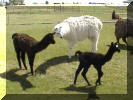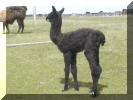|


| |



Our very pregnant Emmy, similar to what happened recently with
Sunshine, was
overdue by a month. She began showing signs of distress so was taken to WSU
Pullman via our "llama ambulance".
She was diagnosed with a uterine torsion. This was a 180 degree twist in the
forward portion of the uterus, blocking passage of the cria and possibly
blocking blood flow to the placenta. Both mom and cria were at serious risk.
No heartbeat could be found on the cria, and a dead cria with no way to be
expelled can poison the mother beyond treatment in just a couple days. Emmy was
rushed into emergency surgery for a Cesarean. The cria was extracted alive
(barely). Limp and looking lifeless, she had a heartbeat but wouldn't breathe
real well on her own. She was put on oxygen and rushed to the ICU. Her
temperature quickly dropped from the normal 101F to 92F whereupon she stopped
breathing, though the heartbeat remained steady. Mouth to snout respiration was
required a couple times until a breathing stimulant (doxapram) was
administered. She was wrapped in a warm water blanket and vigorously massaged.
The prognosis wasn't good, being totally unresponsive to touch, but she
gradually came around and in a couple hours was up and walking around.
Temperature, respiration and breathing were all normal -- with weight a rather
typical 24 lbs., though she looked quite thin. Despite being a month overdue,
she had characteristics of being premature -- a condition referred to as dysmaturity.
As expected, being a Pepper baby, she's very black, except for a white patch on
the forehead and chin. We named her Juniper Dune (the surgeons initially
named her Pork Chop after seeing the forehead patch). Emmy is recovering
from surgery and is doing okay so far. She was a bit slow to accept the cria
as her own following this abnormal experience (and being a first-time mom to
boot). To start with it was like this was a strange baby --
typical adult llama concern for all crias, but not like it's her own. The cria totally gave up trying to nurse from mom (which mom doesn't tolerate), but
has taken to the bottle ok. Emmy would later give her "llama kisses" to
transfer stomach flora. Emmy has virtually no milk, again like Sunshine, so it
was 100% bottle feeding. Unfortunately, the evening of the fourth day
Juniper quit eating. We took her to the local vet the next day, whereupon
she was diagnosed with an obstructed (malformed due to the dysmaturity) colon.
Everything she had been eating was backed up with nowhere to go. We were left with no choice
but to have her put down.
So here we are with a third problem birth in a row from two dams - four from
three dams if counting the one very early abortion. The common symptoms
we've observed of
lengthened gestation, no milk, dysmaturity, weight loss, high water
consumption, heat stress (standing in water), etc. are all
consistent with what I have
read about endophyte poisoning in horses (and
cattle).
Suspecting this, I gathered samples of grass tillers all around my five acres
and ran an immunoblot test on them. Sure enough, the southern half of my south
field, the holding pens, and a portion of the north field is heavily (100% of
samples) infected with Neotyphodium. The remaining areas came up with only a
few infected samples. The south field is the closest to the house, so is
where we confined the expecting girls to keep a close watch on them, not
realizing we were confining them to the area of highest endophyte concentration!
So it appears I've finally identified the source of all the problems we've been
having. The cure is to eradicate all the grass and replant.
This will require Roundup, till, leave fallow, Roundup whatever
reemerges, and replant. When I replant, I'm testing the seed myself this time.
This serves as a lesson that vendors cannot always be trusted when it comes to "endophyte
free" pasture seed.
|

